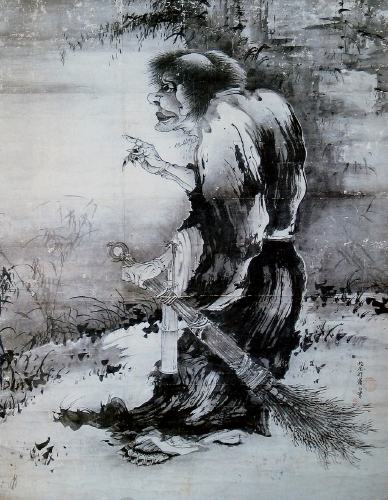ZEN MESTEREK ZEN MASTERS
« Zen főoldal
« vissza a Terebess Online nyitólapjára
曾我蕭白 Soga Shōhaku (1730–1781)
Zen Paintings
An innovative, prolific painter active during the Edo period (1600-1868), he is often categorized as an individualist and eccentric. Shohaku was believed to be a native of Ise Province (now Mie Prefect.), but recent scholarship suggests that he was born into the merchant Miura family of Kyoto. Shohaku seems to have adopted the family name Soga in his mid-20s, probably to enhance his reputation as a painter and to suggest that he was heir to one of the great lineages of Japanese ink painting. He claimed to be the tenth generation descendant of Jasoku, an artist's name (go) employed by Echizen Soga artists. He also used a seal which read 'Jasokuken'. Like several earlier Soga painters, he painted figural subjects based on Chinese legend. His works include many expressive paintings executed in monochrome ink, but his idiosyncratic style was apparently not based on paintings by other Soga artists. Always charged with great energy, his brushwork is sometimes broad and abbreviated, and sometimes complex and convoluted. Among Shohaku's best-known ink paintings are the screens (byobu) The Four Sages of Mount Shang, Pavilions in Landscape, An Immortal Producing a Storm and The Immortal Kume (Boston, MA, Mus. F.A.) and the pair of hanging scrolls (kakejiku) of Kanzan and Jittoku (Kyoto, Koshoji).
http://blog.livedoor.jp/tama173/archives/1094779.html
Soga Shōhaku (1730–1781) was a Japanese painter of the Edo period. Shōhaku distinguished himself from his contemporaries by preferring the brush style of the Muromachi period, an aesthetic that was already passé 150 years before his birth. Shōhaku's birth name was Miura Sakonjirō. His family was wealthy, but all of his immediate family members died before he reached age 18.
https://en.wikipedia.org/wiki/Soga_Sh%C5%8Dhaku
Soga Shōhaku, original name Miura Sakonjirō (born 1730, Ise or Kyōto, Japan—died Jan. 30, 1781, Kyōto), Japanese painter of the mid-Tokugawa period (1603–1867) who tried to revive the brush-style drawing of the great masters of the Muromachi period (1338–1573).
As a young man he studied painting under the guidance of Takada Keiho of the Kanō school (school of painting based on Chinese subject matter and techniques) in Kyōto, but his disillusionment with contemporary art led him to look into the past. He came particularly to appreciate the works of the Muromachi painter Soga Jasoku and called himself Jasoku ken, or Jasoku jussei (“the tenth”). He excelled in ink monochrome portraits, which he made with powerful brushwork using broad strokes. The two-scroll painting “Kanzan and Jittoku”—two Chinese monks of the T'ang dynasty —is a good example. He also drew pictures of weird and demoniac quality and, being of a haughty disposition and an eccentric, was regarded by many as either a madman or an anachronism. He had no successors to carry on his style.
http://www.britannica.com/biography/Soga-Shohaku

達磨図 Daruma

達磨図 Daruma

南泉斬猫図 Nansen Cuts the Cat in Two, 116.3×51.3cm

蜆子像 Kensu zo
Xianzi (Kensu), the Shrimp Gatherer
114.2 x 50.4 cm
Museum of Fine Arts Boston

寒山拾得図
Kanzan & Jittoku


寒山拾得図
Kanzan & Jittoku

寒山拾得図
Kanzan & Jittoku

寒山拾得図 Kanzan & Jittoku

寒山拾得図
Kanzan & Jittoku

寒山拾得図 Kanzan & Jittoku
Formerly attributed to: Soga Shôhaku (1730–1781)
126.8 x 48.1 cm
Museum of Fine Arts Boston

寒山拾得図
Kanzan & Jittoku

虎図 Tiger

龍図 Dragon